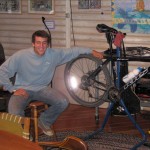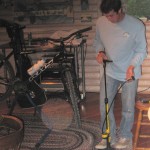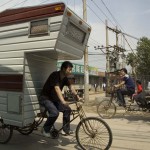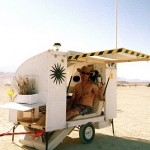by Catherine Haug
Presenters: Peter Hall and Cameron Clayton of Mountain Mike’s Bikes in Bigfork (mountainmikesbikes@gmail.com). In addition to maintaining their own rental bikes, they also do repairs on others’ bikes. They sometimes sell their used bikes at the end of the season, but may not do so this year.
Topics covered:
- General Cleaning and Maintenance: includes Chain Maintenance, Gear and Derailer Maintenance, Brakes, and Repair when on the Road.
- Changing a Tire
- Bike Tool Kt
- Positioning a Bike Seat
- Carrying Cargo
See Gathering Summary: Bikes and Bike Maintenance for a printable pdf version of this summary.
General Cleaning and Maintenance
(photo by Edd Blackler)
- After every use, hose it down and wipe dry;
- At least weekly, clean the derailers and moveable brake parts;
- Every 2 weeks, lube the chain and derailers;
- Brakes don’t need routine maintenance, but may need alignment or brake pad replacement.
Chain Maintenance
Lube the chain: they recommend using a degreaser such as Finish Line Wet Lube: put a bead down the middle of the chain while using the pedal to slowly move the chain. Don’t overdo. Then work in by moving chain through several cycles. Wipe off excess. Best done 24 hours before using again, to give it time to evaporate.
Gear and Derailer Maintenance
Oil front and rear derailers: they recommend Tri Flow or any penetrating oil, but do not recommend WD-40. Apply oil to each derailer’s eight points, then wipe off.
Check gears: after oiling the rear derailer, run bike through its gears while moving the pedal. Check for even shifting. If it skips gears, it means the derailer(s) are dirty. A click sounds with each gear change; the derailer should cause the chain to move to the next gear right after the click.
Shifting up and down: use barrel adjuster: loosen to go to high gear and tight to go to low gear. Has opposite turn as a screw. To loosen cable, tighten the adjuster.
Brakes
Adjust Brakes: brake handles should be parallel with the handle-bar when properly tight. Adjust with barrel adjuster, which has opposite turn as a screw.
Brake repair is best done by a professional.
Repair when on the road
To work on bike on the road, such as to check gears or chain, it’s best to put the bike upside down on the ground.
Changing a Tire
Peter demonstrated how to remove, repair and reattach a front tire.
Remove and repair tire
Use a Quick Stick to remove tire from rim: put the knob under bead of tire; pop it, then pull out as work around wheel with hands.
Once off, check for cause of leak. First check the rim:
- check inside groove of rim;
- check that rim strip (yellow) is in tact. It guards tire from the end of each spoke
- run finger along inside rim (sidewalls, etc.) for slivers, hawthornes, etc..
Then the tire, inside and out: put over shoulder and work around the tire with fingers. Check for tears.
Resolve problem and patch tube.
Reattach tire to rim
Question: What is the white powder sometimes seen on a tube? Answer: It’s baby powder; helps to prevent pinch-flats and snake bites. It lubricates tube against side wall. Put along inside of tire before you put the tube in.
Put a little air in tube and fit inside tire. Then put tire on rim, first putting valve through hole in rim, then fit tire into rim with your hands.
Check that sidewall is inside the rim: Put on floor and with pressure, walk (roll) tire around floor to check. Make sure the tire’s beads are stuck inside the rim, to avoid a blow-out. (The bead is a strip of metal on the inside of the tire).
Fill tire
(photo by Edd Blackler)
Bike tires have the same Schraeder Valve as a car tire. Pump up the tire to desired pressure.
Proper tire pressure:
This depends on terrain of where you plan to ride, by improving traction over rough ground, or speed on the highway:
- loose, rough ground: lower pressure, 30 – 40 psi
- hard ground and asphalt: higher pressure, as high as it will go, 50 – 60 psi
- mid range of 45 – 50 psi is recommended for combination ground.
Pumps
Floor pumps cost about $60 – $100. Each pump adds about 1 pound pressure (30 – 40 pumps to get 40 psi).
Bike tool kits (see below) come with tiny CO2 pump, about the size of a coin. You put this to a CO2 canister to fill tire. Great for emergencies.
Changing a Rear Tire
- You don’t need to remove the chain except with single-gear bikes.
- Release quick-release: press fist against top of tire and wheel pops right out.
- If have rim brakes, you need to open them up before remove the wheel.
- When put wheel back on, chain goes on bottom side of gear (bottom of chain), and on top of top gear.
- Should start to feel pressure on quick-release when at about 45º.
Tool Kit
A good kit should include:
- quick stick
- spare tube
- pump and/or CO2 kit
- patch kit
- wrenches
- chain breaker
- lubricants (optional)
Positioning a Bike Seat
Your leg at the bottom of pedal stroke should be almost fully extended (knee almost locked).
Pedal Clips and Toe Grips
Toe grips do help save energy when pedaling (about 20%), but can be difficult to remove foot quickly.
Clipless pedals: shoes clip into them; easier to remove your foot. It takes some practice to get hang of removing foot (slight twist). Practice on lawn first.
Carrying Cargo
(photo from www.scooteringusa.com)
Prior to our gathering, Catherine discussed cargo bikes with Bruce at Bikology. Bruce says that cargo bikes are not as efficient as trailers, mainly because they are heavier bikes. Trailers can haul over 100 pounds of gear.
Trailers come in single-wheel and two-wheel varieties. Bruce recommends two-wheel for most uses, as they are more steady. But if doing highway ride, Edd B. points out that single wheel trailers takes up less space.
Peter and Cameron suggest:
- Surly makes good cargo bikes, made of steel or aluminum;
- Burley makes trailers.
Bike Paths
(photo from http://1.bp.blogspot.com)
The rotary Club plans to extend the Nature Trail bike path in a loop to highways 83 and 35.
Edd suggests that whenever a new road project is identified, we should demand that right-of-way be obtained for bike paths. Flathead County already has a policy of requiring that new developments grant bike path easements.



